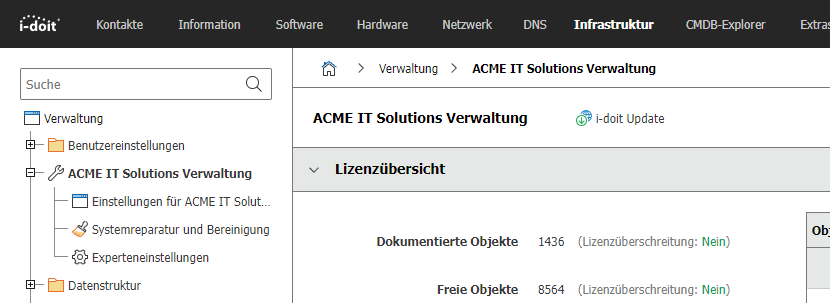Hallo zusammen,
ein kurzer Hinweis aus dem "Maschinenraum"  Wenn ihr eigene CSS Dateien verwenden möchtet könnt ihr diese für gewöhnlich einfach nur in den Ordner
Wenn ihr eigene CSS Dateien verwenden möchtet könnt ihr diese für gewöhnlich einfach nur in den Ordner src/themes/default/css/ legen - i-doit wird diese dann sammeln und cachen (wobei die style.css immer zuerst und mit Priorität geladen wird).
Wir lesen uns dieses Thema natürlich durch und möchten in den kommenden Versionen darauf eingehen. Das Redesign ist nicht mit i-doit 1.19 "abgeschlossen".
Aber zurück zum eigentlichen Thema:
Alternativ wäre es auch möglich die eigenen Stylesheets mittels Add-on bereitzustellen, dafür braucht ihr eigentlich nur eine PHP Datei mit folgendem Inhalt und eine entsprechende CSS Datei:
<?php
// file "src/classes/modules/custom-style/init.php".
isys_application::instance()->container->get('signals')->connect('mod.css.attachStylesheet', function () {
// file "src/classes/modules/custom-style/style.css".
return __DIR__ . '/style.css';
});
Das ist eine stark vereinfachte Form eines Add-ons, die sich auch nicht mittels Admin-Center installieren, aktivieren, deaktivieren oder deinstallieren lässt. Wenn man es "richtig" machen möchte kann man sich den entsprechenden KB Artikel durchlesen 
Der Vorteil dies mittels Add-on zu lösen ist in erster Linie, das Add-ons (bzw. deren Code) nicht von i-doit Updates angepasst werden - somit könnte diese Lösung über mehrere Versionen erhalten bleiben. Und es hilft natürlich auch solche Anpassungen an eine "dafür vorgesehene" Stelle zu packen anstatt direkt Änderungen im Kern Quellcode vorzunehmen... Davon möchte ich dringend abraten 
Viele Grüße
Leo
 Was ist dein Use-case? Wenn du nur bei bestimmten Kategorien "reagieren" möchtest kannst du einfach die übergebene "DAO" prüfen (z.B.
Was ist dein Use-case? Wenn du nur bei bestimmten Kategorien "reagieren" möchtest kannst du einfach die übergebene "DAO" prüfen (z.B. 


